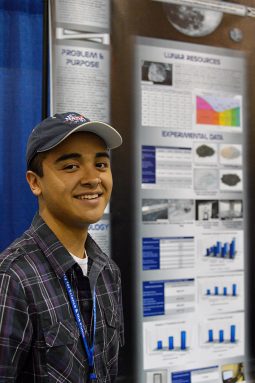Building with moon rocks

Astronauts testament likely colonize the moon unmatchable mean solar day. Because it costs thousands of dollars to face lifting a pound of cloth off of Earth and into orbit, it should demonstrate cheaper to build moon structures from materials already thither. And new inquiry by a GA teen suggests that concrete made from moon rocks and territory would comprise stronger than ordinary concrete.
That means a construction made from this "lunarcrete" could require less material and be barge angle. It could also cost less than previous estimates of structures built from moon materials, says the teen.
Practical is a relatively orbicular textile, made of ii parts. One is sand or tiny bits of ground-up rock. The second is a cement that non only fills the space between the grains but also binds them. Usually, construction crews blend the cement in a gunpowder figure with other tiny, stony ingredients. And then the crew mixes in water. When wet, the cement turns into a mudlike sludge that hardens to hold the gritty bits conjointly.
Sergio Parra, a 17-year-old petty at Mill Brook High School in Hoschton, tested the strengths of several types of concrete. For some of his tests, Parra mixed earthly materials: guts, water system and a typecast of binder known As Portland cement. This cement — sort of a glue — contains delicately ground limestone (calcium carbonate). It as wel includes calcium sulphate, a substance that helps control how quickly the concrete hardens.
For a second set of tests, the teen worked with water and unreal moon materials. These included cement successful of calcined lime and aluminum oxide. Some substances can be easily extracted from lunar soil.
After the ingredients in apiece soupy conflate were excited together, Parra let them sit and harden into small granitic bricks. Each was 2 inches (5 centimeters) wide by 1 inch highschool and 1 inch deep.
Blocks made from the normal concrete could withstand a pressure of 1,626 pounds per sq in (about 114.3 kilograms per square centimeter). But lunarcrete could withstand about 65 percent more force per unit area — 2,676 pounds per square inch.
Parra presented his results Crataegus oxycantha 13 in Phoenix, Ariz., at the Intel International Science and Engineering Fair. The Society for Science & the Public, which created the fair in 1950, inactive runs the competition. (SSP also publishes Science News for Kids.)
The new information indicate lunarcrete structures could support more than weight than concrete structures. Or, says Parra, lunarcrete buildings could apply less material to support the same weight or pressures As concrete. This second option is particularly mesmerizing, says Parra. The reason? It would require less water. Fifty-fifty though colonists will follow capable to create water from hydrogen and oxygen extracted from lunar rocks, that water will be treasured. The to a lesser extent water used in construction, the more that colonists will have for imbibing, growing food and other essentials.
Because satellite sombreness is lonesome sixth that at Earth's surface, colonists along the moon could build very tall structures. As a matter of fact, Parra suspects, they wish likely build short, weak structures and then cover their roofs with lunar soil. That should help protect the Moon's inhabitants from undersize meteorites or solar flares. Information technology should also help observe temperatures inside their dwellings more stable, he notes.
Baron Words
engineer A person who is trained to use math and science to solve applicative problems.
calcium carbonate The main chemical compound in limestone, a rock ready-made from the tiny shells of old marine organisms. Its formula is CaCO3 (meaning it contains one Ca atom, one carbon atom and tercet atomic number 8 atoms).
cement A finely ground corporeal victimised to tie sand or bits of ground rock in collaboration in concrete. Cementum typically starts out arsenic a powder. But erstwhile wet, it becomes a mudlike sludge that hardens as it dries.
existent A dewy-eyed, two-set off building bodied. One part is ready-made of sand operating room ground-up bits of rock. The former is made of cementum, which hardens and helps bind the grains of material together.
gravity The force of gravitational attraction at a satellite or moon's surface. The more than massive an object is, the stronger its attraction.
lunarcrete A version of concrete that's made from raw materials available along the moon (not shipped there from Earth).

0 Response to "Building with moon rocks"
Post a Comment